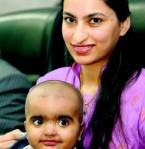
Shaheer Imran from Islamabad was treated for a rare blood disease thanks to the cord blood donations of two strangers in India. The toddler had Familial HLH, a typically fatal disorder that is usually treated by stem cells from close family members. There were no acceptable donors in Shaheer’s family, however, so doctors at Sir Ganga Ram Hospital in New Delhi sought two donors from Reliance Cord Blood Bank in Mumbai. This was probably the first time that a double cord blood stem cell transplant has been made in India. Shaheer is now recovering well, and his case demonstrates the growing potential of banking an infant’s cord blood.
As we mentioned when discussing cord blood banking last year, umbilical stem cells have amazing healing potential. Not only that, but they are a guaranteed match to a child who may be otherwise unable to provide stem cells for autologous treatments in the near future. Shaheer’s case, however, demonstrates another benefit to cord blood banking – anonymous donations to other infants in need. Because Shaheer’s HLH had a genetic basis, he was unable to provide his own stem cells, and his family was not a match. The two separate donors from the Reliance Cord Blood Bank gave him an otherwise unobtainable chance at life. That’s a powerful gift. And due to the particulars of this situation (Shaheer is Pakistani and the donors were presumably Indian), there were even possible political benefits as discussed in the video from IBN Live below:
Stem cell treatments are still in their infancy, but Sir Ganga Ram Hospital had performed dozens of these therapies for HLH conditions similar to Shaheer’s. Typically, however, donations come from a close family member’s stem cells. Shaheer is an only child, however, and had no familial matches. According to Doctor India News, Shaheer is only one of ten or so children in India to receive an anonymous cord blood transplant. Not only did Ganga Ram doctors use an unrelated cord blood donor, they used two – another rarity.
Because HLH destroys the body’s own cells, doctors had to first put Shaheer through chemotherapy before the transplant which was performed on March 15th. According to India Today, it took three weeks for the new cord blood stem cells to start producing new white blood cells, and an additional week for platelets. This seems to be right on schedule as doctors are optimistic about Shaheer’s long term success. Typically 72% of those treated for HLH with stem cells live past early childhood (Ganga Ram officials via India Today).
Parents who save a child’s cord blood are really taking a shot in the dark. The chances that their child will actually need an autologous stem cell transplant are slim. The number of diseases treated in this way are relatively few, though new therapies (such as the one we discussed for Cerebral Palsy) are arriving every day. Shaheer, however, demonstrates that banking cord blood isn’t necessary just an insurance policy for the donor child – it can be a powerful tool to help save someone else’s life as well. While it’s still not clear if cord blood banking will make financial sense for many family’s, the medical potential is growing. News like this may fuel an increase in the number of parents who elect to bank cord blood. In the meantime, best of wishes to young Shaheer and his family, and kudos to the donors in Mumbai who made saving his life possible.
[image credit: Doctor India News]
[source: Doctor India News, India Today, The Hindu, Sir Ganga Ram Hospital]


